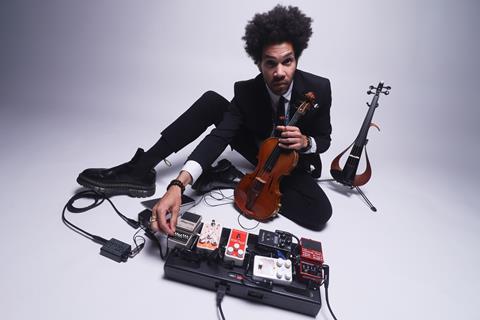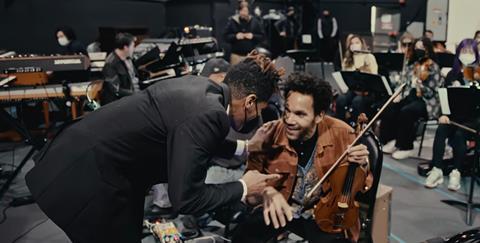The French violinist on his journey into jazz and how the principles of improvisation broaden expressive capabilities and encourage flexibility, imagination and a deeper connection to music, regardless of genre

Discover more Featured Stories like this in The Strad Playing Hub.
Growing up in the Parisian suburbs, in a DIY environment where self-reliance was vital, I always sought ways to adapt as an outsider, especially when attending the conservatoire in Paris. My musical journey began at three years old when my parents enrolled me in an initiation class at our local conservatoire, the Conservatoire Francis Poulenc in the 93rd district suburbs in Rosny-sous-Bois, where I first delved into percussion and piano and then started solfège before choosing an instrument the following year.
At age six I came across an orchestra performing Mendelssohn’s Violin Concerto on our black and white TV. I was stunned by the sound of the solo violin, and I vividly remember how it made me feel. It transported me into an imaginary world in which I was riding a horse in the middle of the town like a knight. It made me feel happy and adventurous and, at the same time, melancholic and aware of my own emotions. The next day, I asked my parents for a violin and began lessons at the conservatoire.
Everything seemed to go according to the path the conservatoire had already decided for me. But at 14 years old, I discovered another world of possibilities: improvisation. It was by accident after hearing a jazz band playing in a local bar. I went on and sat in without knowing what jazz was, let alone improvisation. I remember using my ears and moving my fingers to match the sounds and the tempo. It became an obsession, and I started listening to all the records we had at the local library, taking one a day, spending the entire day listening and playing along, and then taking another the next day.
But ultimately, I felt isolated in my journey. Nobody around me was improvising on the violin, and I sometimes thought I was wasting my life and future by secluding myself in my bedroom for nine hours per day (without eating or hydrating correctly).
From this experience came a lifelong journey of defining and redefining my sound. Being a jazz violinist is not a departure from classical violin traditions but a new world. Jazz violin, while still in its formative stages compared to the centuries-old classical repertoire, offers unique angles and expressions. This divergence stems partly from jazz’s relatively recent emergence in the early 20th century, unlike the classical violin’s origins in the 1500s. And this youthfulness provides the freedom to explore and innovate, especially through improvisation.
Improvisation is about balancing control and flexibility. When you improvise, you allow the physical, emotional, and mental environment to influence your direction. It’s easy to confuse disorganisation with openness. The same goes for organisation and over-preparedness. The latter can prevent you from improvising. And so, the equation can easily slip into organisation = control, and disorganisation = freedom. Ultimately, having expectations and being stiff will jeopardise your ability to innovate and grow.
My philosophy is that improvising is ‘organising as you go’. It takes daily practice to find the right balance between control and flexibility in life more generally. And sometimes the most challenging moment is this point of departure.
How do you make that first mistake? By leaning into the unknown. That means trying something new. In my life, it started when I heard this local band and then moved to a new continent. But it’s different for everyone, and it can be anything. Like going to a different coffee shop than usual or walking down a different sidewalk on your way to the groceries. Just try it! Small changes slowly give you a new perspective, and musically that may mean exploring new ideas or starting a new project.

My musical expression has been shaped by the unique context in which I was first introduced to music. Initially, classical studies and an early exposure to jazz and improvisation. It has opened doors to composition, orchestration, and arranging, as well as contracting orchestras and bands for artists like Usher, Jon Batiste, Bad Bunny, and Kim Burrell. I am also the first Professor of Jazz Violin at the University of North Texas, where I use improvisation and alternative styles to offer a renewed perspective on music in general.
This benefits string players from all walks of life, whether they are classically trained, fiddle players, hip-hop players, jazz players or anything else. The common denominator here is awareness of the harmonic and rhythmic context, allowing the player to choose their own adventure. Once harmony is understood, the musician can choose notes that complement the underlying harmony, thereby creating a new path within the same harmonic context. And awareness of the rhythmic context involves not only keeping time but also understanding the feel or groove of the piece. These two things serve as a musical toolkit, equipping musicians across all genres with the means to explore, innovate, and communicate their artistic visions more effectively.
For instance, the first phrase of the opening of the Sibelius Concerto for Violin in D minor starts with the fourth (G), goes into the fifth (A) and resolves with the root (D). The second phrase continues with D, F and back to D (after an enclosure). Once you are aware of this, you could essentially improvise the opening by targeting different notes; the first phrase could start with the third, then the fourth, and resolve on the root. This approach broadens one’s expressivity and skill set and prepares them for today’s versatile music industry.
In a world that often seems torn between reverence for the past and the push toward the future, it helps to remember that the principles of improvisation were once an integral part of a classical musician’s culture. Bach, Mozart, Beethoven, and Schumann were all known for their improvisational skills. This demonstrates that tradition, paired with an improvisational mindset and openness to other influences, can complement and enhance one another, offering musicians the freedom to innovate in real-time. The improvisational spirit encourages a dialogue between musicians, their instruments, and the audience, transforming each performance into a unique experience. Classical musicians, inspired by this approach, can breathe new life into centuries-old compositions, interpreting them with a deeper understanding of the context and making them new again.
Read: ‘Your own voice must be in charge’: Creating an improvised violin concerto
Read: How I improvised a medieval soundtrack at a comedy improv show
Discover more Featured Stories like this in The Strad Playing Hub.
The number one source for playing and teaching books, guides, CDs, calendars and back issues of the magazine.
In The Best of Technique you’ll discover the top playing tips of the world’s leading string players and teachers. It’s packed full of exercises for students, plus examples from the standard repertoire to show you how to integrate the technique into your playing.
The Strad’s Masterclass series brings together the finest string players with some of the greatest string works ever written. Always one of our most popular sections, Masterclass has been an invaluable aid to aspiring soloists, chamber musicians and string teachers since the 1990s.
American collector David L. Fulton amassed one of the 20th century’s finest collections of stringed instruments. This year’s calendar pays tribute to some of these priceless treasures, including Yehudi Menuhin’s celebrated ‘Lord Wilton’ Guarneri, the Carlo Bergonzi once played by Fritz Kreisler, and four instruments by Antonio Stradivari.













































No comments yet